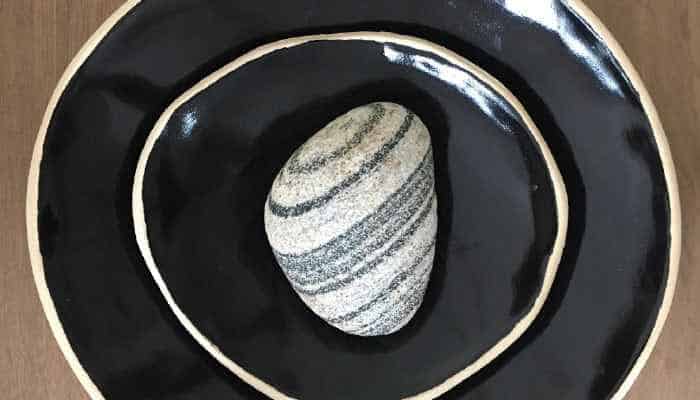The clay works of East Hampton ceramicist Anna Clejan are a study in contrasts – both organic yet glossy, delicate yet strong. Very strong, says the artist. It seems odd to say, but these works of art are dishwasher and microwave safe.
While her pieces – plates, platters and bowls, many, many bowls – are formed of stoneware they often resemble the fine and silky qualities of porcelain. And that’s intentional. “I resonate with the Japanese aesthetic of wabi-sabi, perfectly imperfect simplicity,” she says.
Clejan, also an interior designer, works out of East End Clay Works, a cooperative of fellow potters on East Hampton’s Gingerbread Lane. She begins by rolling out her clay through a slab roller like a very thin pie crust. After deciding what shape the piece will take, she places it in a form to keep the shape while it dries.
While the forms are standardized, once the pieces leave them her artistry begins. Here is where she manipulates the material to add her own personal touches. “Even if someone else uses the same form the finished product doesn’t look like what I make.” First, she smooths out the edges. “If you put your lips up to it it’s got to feel good. If it’s a serving dish it needs to feel good as the spoon scratches against it.” She has started experimenting with texture by scratching or rolling different types of texture on the surface.

Next she puts it in the kiln for its first firing. When it comes out it is called “bisque,” and is now sturdy enough to glaze. “I always know what glaze I’ll be using while I’m making the piece, “she says. There are dozens of glazes at the studio but Clejan has only a handful of go-to glazes, mostly neutral: Shiny Black (which she always uses with a contrasting shiny or matte white on the exterior or interior), Horizon or Creamy white and Pewter Matte – “People love that one.”
While the above are all dipping or pouring glazes, she also loves the Matte Turquoise, which must be painted on. “You have to give it five coats to give it that rich color,” she says. But the time and labor intensive process is well worth it as it evokes a “Hamptons feeling of summer, ocean and sky.”
Before arriving on the South Fork, Clejan had a considerable background in art, first studying it in Switzerland then at Marymount Manhattan College where she took a ceramics class and “fell in love with the medium.” She took up studies at the Greenwich Pottery House on Jones Street in New York, where she thrived not only taking classes but also “using the studio every single day.”

“I had a lot of anxiety during that time and when I was in the studio I felt it literally go away into the work I was creating. I felt I needed it.”
After going out onto her own, an enterprise she didn’t enjoy – “There was no sense of community” – she took a hiatus from pottery to have kids and to partner in Modern Net Zero, a local building firm specializing in modern houses that incorporate green technology, where she is lead designer.
She returned to making ceramics again eight years ago. While most of her pieces are bowls – she particularly likes nesting bowls whether large or small – she also makes such items as serving spoons and bud vases, which can also be used for drinking espresso or wine. All of Clejan’s ceramics enjoy a natural shape, which takes place in the firing.
She especially enjoys making pieces for the display of food. “I cook and have a family so when I put time into making a meal I love having that aesthetic. It elevates the whole experience of eating.” As for mugs? “I don’t love pottery mugs,” she says. “But maybe one day I’ll make elegant mugs.”










!['The Maples' is a prestigious generational compound of two extraordinary estates: 18 Maple and 22 Maple. This rare offering, designed by luxury architect Lissoni partners New York and developed by visionaries Alessandro Zampedri-CFF Real Estate and JK Living, redefines opulence with the highest quality of craftsmanship and captivating views of the Atlantic Ocean. Represented by @nycsilversurfer and @challahbackgirl of @douglaselliman. [link in bio]](https://hamptonsrealestateshowcase.com/wp-content/uploads/sb-instagram-feed-images/438891010_1083749139481747_7890082604579275354_nfull.jpg)
![Featuring 360-degree water views on Mecox Bay, the Atlantic Ocean and Channel Pond, 1025 Flying Point offers the ultimate beach cottage that is flooded with natural light. With panoramic views, proximity to the ocean, and a private walkway to Mecox bay for kayaking or paddle boarding, this truly is a special retreat. Represented by @ritcheyhowe.realestate and @hollyhodderhamptons of @sothebysrealty. [link in bio]](https://hamptonsrealestateshowcase.com/wp-content/uploads/sb-instagram-feed-images/438994305_737511778456166_4602476013493875279_nfull.jpg)
![Attention advertisers! 📣 Secure your spot in the highly anticipated Memorial Day edition #HRES. Reach thousands of potential clients and showcase your brand in one of the most sought-after publications in the Hamptons, NYC, Palm Beach, and beyond. Contact us now to reserve your ad space! [link in bio]](https://hamptonsrealestateshowcase.com/wp-content/uploads/sb-instagram-feed-images/438549843_275102939023235_6718257301437562124_nfull.jpg)
![You eat with your eyes, and on the East End, it’s important that what you eat looks just as good as how it tastes. At @rosies.amagansett, the restaurant itself is plenty photo-worthy with blue ceramic tiling and yellow and white striped fabric wallpaper. But for a dish that will light up your photos, head directly to the salmon tartare! [link in bio]](https://hamptonsrealestateshowcase.com/wp-content/uploads/sb-instagram-feed-images/437094269_7296727147115953_1594410326824303644_nfull.jpg)

![We were honored to be the media sponsor for @blackmountaincapital's open house event with @jameskpeyton and @jfrangeskos at 11 Dering Lane in East Hampton! Other sponsors included @landrover, Feline Vodka, @rustikcakestudio, @la_parmigiana, @lahaciendamexicangrill11968, @homesteadwindows, Stone Castle, @talobuilders, and @thecorcorangroup.
A big thank you Carrie Brudner of Black Mountain Capital for putting together this fabulous event! [link in bio]](https://hamptonsrealestateshowcase.com/wp-content/uploads/sb-instagram-feed-images/437081213_762912965932136_6847332836522786568_nfull.jpg)

![Blooms Galore at the Long Island Tulip Festival! 🌷✨ Mark your calendars for April 15th as the vibrant tulips at @waterdrinkerlongisland burst into full bloom! Enjoy a day filled with colorful splendor, food trucks, live music, and more. [link in bio]](https://hamptonsrealestateshowcase.com/wp-content/uploads/sb-instagram-feed-images/437083429_974242677583725_6855805712693638343_nfull.jpg)
